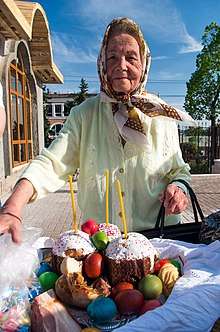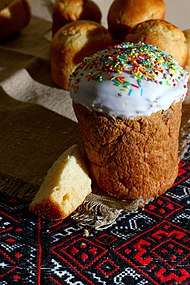Kulich
Kulich[lower-alpha 1] is a Slavic Orthodox Easter bread that has its roots in Kievan Rus. The Paska bread tradition spread in cultures which were connected to the Byzantine Empire and its a traditional cultural part of countries with a Orthodox Christian population. It is eaten in countries like Russia, Belarus, Ukraine, Romania, Georgia, Moldova, North Macedonia and Serbia.[3][4][5][6] Kulich is a variant of paska Easter breads and represents not only Easter but also the spring.[7]
| Type | Bread |
|---|---|
| Course | Before breakfast |


Easter is a very important celebration in Eastern European countries, even more important than Christmas.[8]
Traditionally after the Easter service, the kulich, which has been put into a basket and decorated with colorful flowers, is blessed by the priest. Blessed kulich is eaten before breakfast each day. Any leftover kulich that is not blessed is eaten with paskha for dessert.
Kulich is baked in tall, cylindrical tins (like coffee or fruit juice tins). When cooled, kulich is decorated with white icing (which slightly drizzles down the sides) and colorful flowers. Historically, it was often served with cheese paska bearing the symbol ХВ (from the traditional Easter greeting of Христос воскрес (Khristos voskres, "Christ is risen").
Kulich is only eaten between Easter and Pentecost.[9]
The recipe for kulich is similar to that of Italian panettone.
 Russian paska bread Kulich without frosting and crumbles
Russian paska bread Kulich without frosting and crumbles A painting of people with Easter fare
A painting of people with Easter fare- Orthodox Church of Rome priest (second from right) blesses paschal (Easter) foods including kulichs, eggs, and wine
 Kulich shares the same name as a place in Iran
Kulich shares the same name as a place in Iran
Notes
See also
- Paska (bread)
- Pinca
- Red Easter eggs
- Cozonac
- Panettone
- Stollen
- List of sweet breads
References
- Vasmer's Etymological Dictionary, s.v. "кулич"
- κόλλιξ, Henry George Liddell, Robert Scott, A Greek-English Lexicon, on Perseus
- "Orthodox Easter in Ukraine".
- "Kiev Kulich (Ukraine) - sweet Kiev - dessert Kiev - desserts Kiev - sweets Kiev".
- "Kulich – Russiapedia Of Russian origin". russiapedia.rt.com. Retrieved 2018-09-24.
- "Why No Slavic Easter Is Complete Without Kulich". Kitchn. Retrieved 2018-09-24.
- Kharzeeva, Anna; RBTH, special to (2015-04-10). "Kulich: A cake that means spring, not just Easter". www.rbth.com. Retrieved 2019-03-08.
- "What to Know if You're Visiting Russia on Easter". TripSavvy. Retrieved 2019-03-08.
- Dee, Aliza. "Kulich – Russia's Classic Easter Cake", The Moscow Times, Moscow, 10 April 2015. Retrieved on 29 February, 2016.
External links
| Wikimedia Commons has media related to Kulich. |